Abstract Data Types and Encapsulation Concepts
1/55
There's no tags or description
Looks like no tags are added yet.
Name | Mastery | Learn | Test | Matching | Spaced |
|---|
No study sessions yet.
56 Terms
abstraction
is a view or representation of an entity that includes only the most significant attributes
concept of abstraction
is fundamental in programming (and computer science)
process abstraction with subprograms
Nearly all programming languages support
data abstraction
Nearly all programming languages designed since 1980 support
abstract data type
a user-defined data type that satisfies the following two conditions
hidden from the program units
type's definition
abstract data type condition:
The representation of objects of the type is — that use these objects, so the only operations possible are those provided in the —
single syntactic unit
abstract data type condition:
The representation of, and operations on, objects of the type are defined in a —
Reliability
Advantage of the first condition
by hiding the data representations, user code cannot directly access objects of the type or depend on the representation, allowing the representation to be changed without affecting user code
Program organization
modifiability
separate
Advantage of the second condition
Provides a method of —
aids — (everything associated with a data structure is together)
— compilation
type definition
Language Requirements for ADTs
A syntactic unit in which to encapsulate the —
A syntactic unit to define an ADT
Built-in operations
Common operations
Parameterized ADTs
Design Issues (4)
Assignment
Comparison
Design Issues: 2 Built-in operations
Accessors
Constructors
Destructors
Design Issues: 3 Common operations
packages
Specification package
Body package
Language Examples: Ada
The encapsulation construct is called —
— (the interface)
— (implementation of the entities named in the specification)
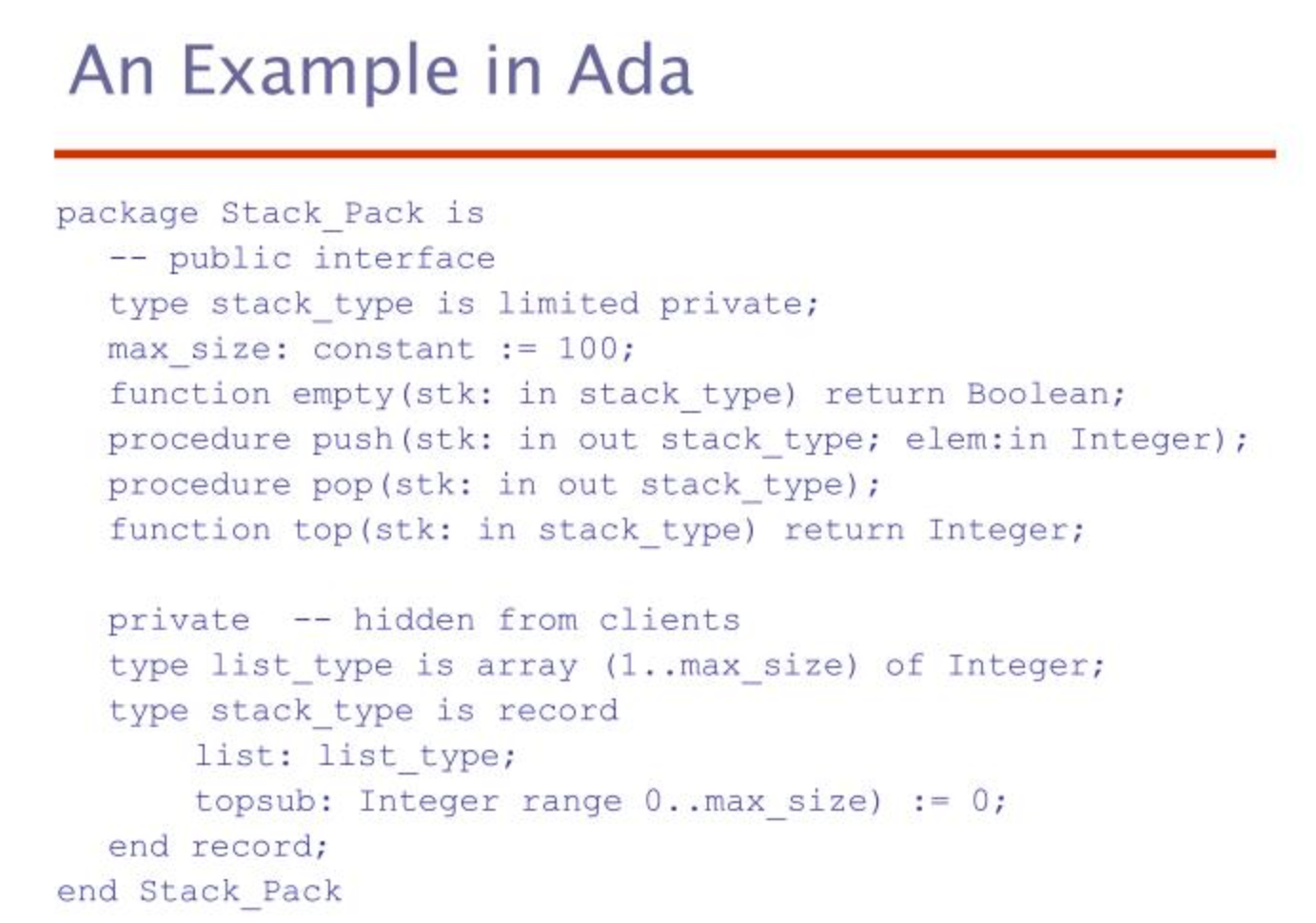
private part
no built-in operations
pointer
pointed-to structure's definition
Language Examples: Ada
Two ways for Information Hiding
The representation of type appears in a part of the specification called the —
More restricted form with limited private types: objects of this type have —
Define the ADT as a — and provide the — in the body package, whose entire contents are hidden from clients.
C struct type and Simula 67 classes
encapsulation device
member functions
class data members
static, stack dynamic, or heap dynamic
Language Examples: C++
Based on (2)
The class is the —
All of the class instances of a class share a single copy of the —
Each instance of a class has its own copy of the —
Instances can be (3)
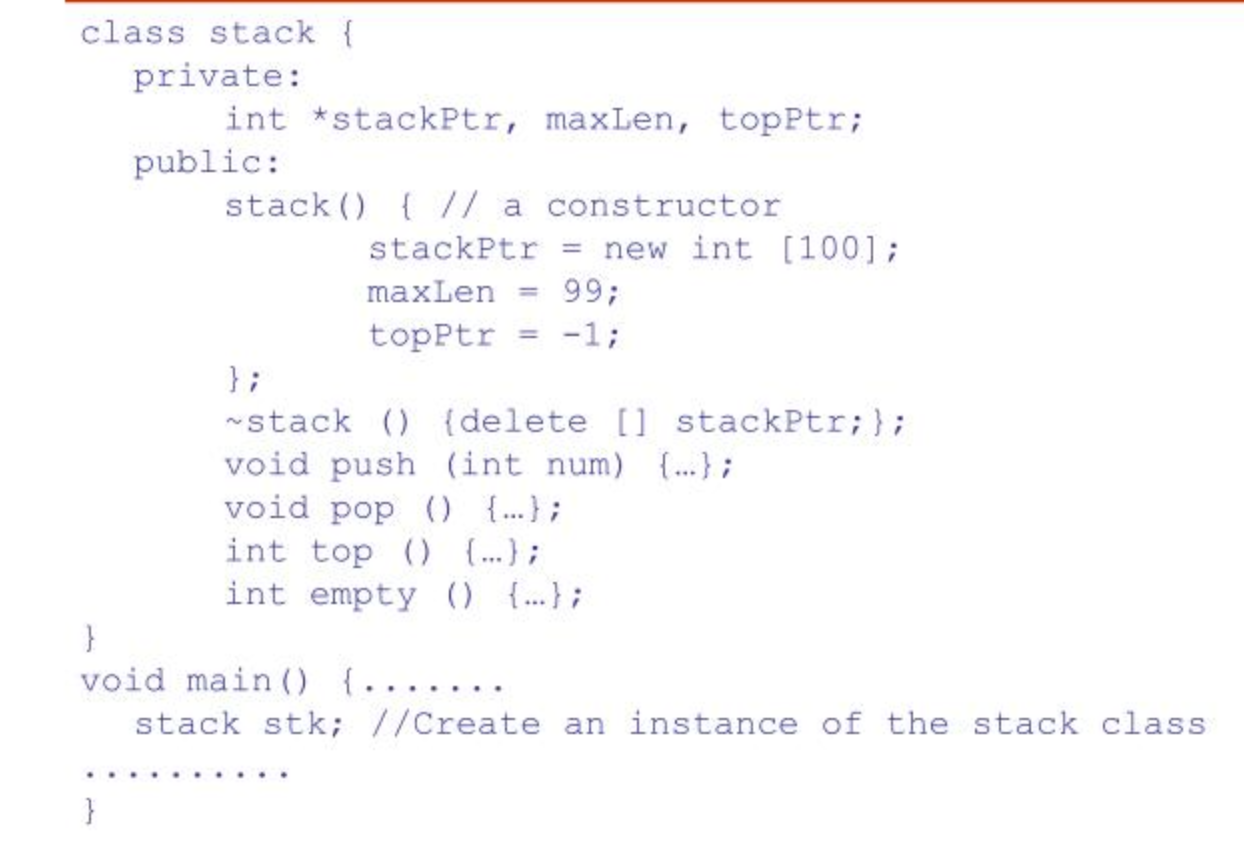
hidden entities
interface entities
inheritance
Information Hiding:
Private clause for —
Public clause for —
Protected clause for —
Constructors
Language Examples: C++
—
Name is the same as the class name
Implicitly called when an instance is created
the objects)

data members of instances
heap-dynamic
parameters
Constructors:
initialize the — (they do not create the objects
May also allocate storage if part of the object is —
Can include — to provide parameterization of the objects
Destructors
lifetime ends
cleanup
Language Examples: C++
—
Name is the class name, preceded by a tilde (~)
Implicitly called when the object's —
— after an instance is destroyed; usually just to reclaim heap storage
Friend functions or classes -
Language Examples: C++
— to provide access to private members to some unrelated units or functions
Necessary in C++
circularly linked list
push
put
class Cell
Language Examples: C++
The class List defines a —
—: add to the front
—: add at the back
The — is used to form lists.

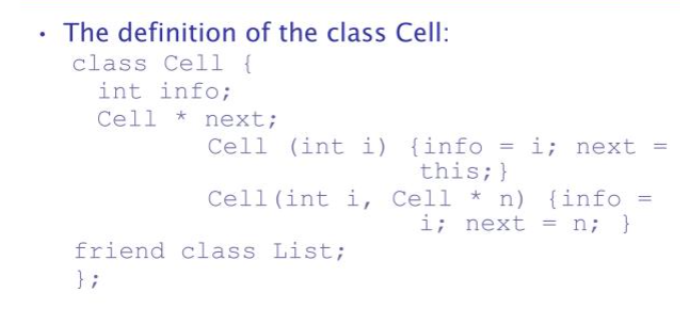
class cell
Language Examples: C++
class list
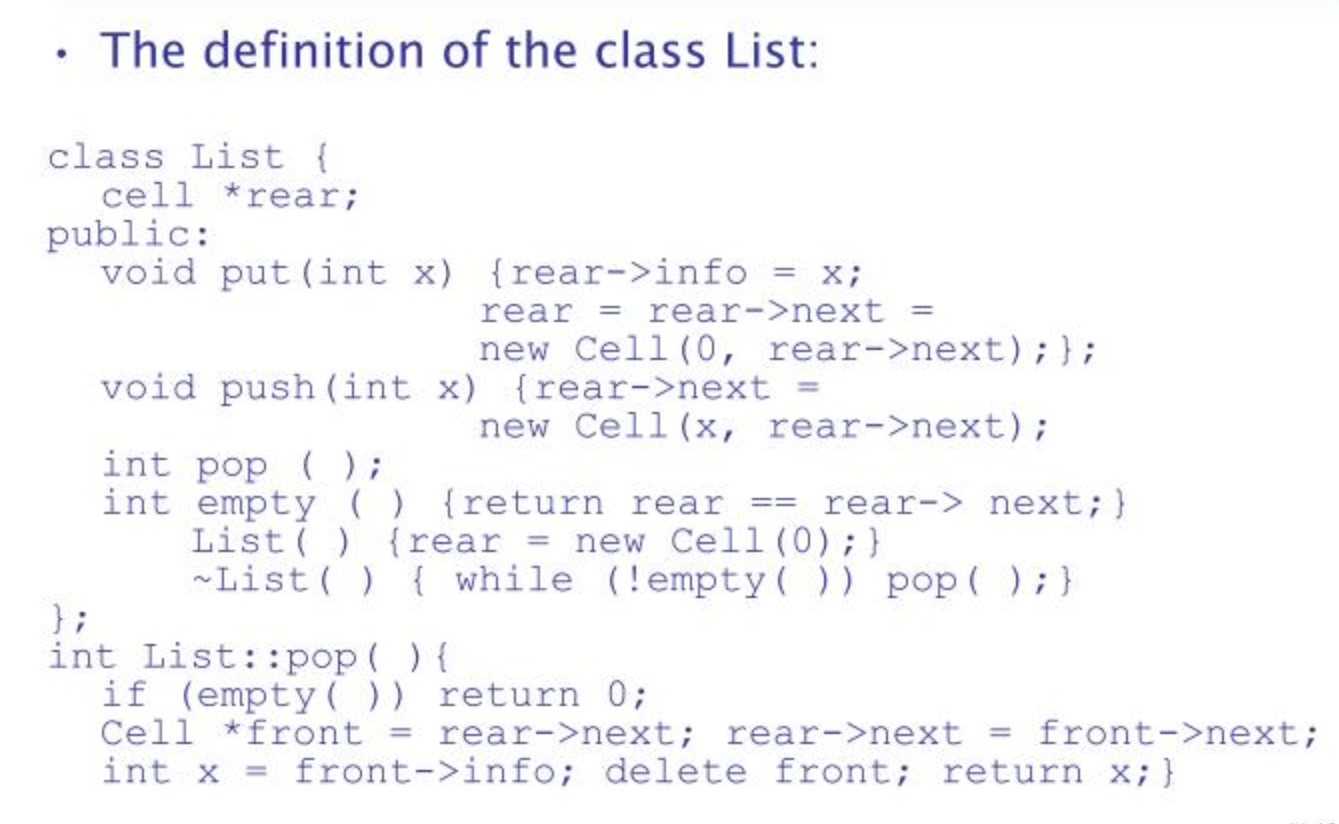
Java
classes
heap - reference variables
Language Examples: —
Similar to C++, except:
All user-defined types are —
All objects are allocated from the — and accessed through —
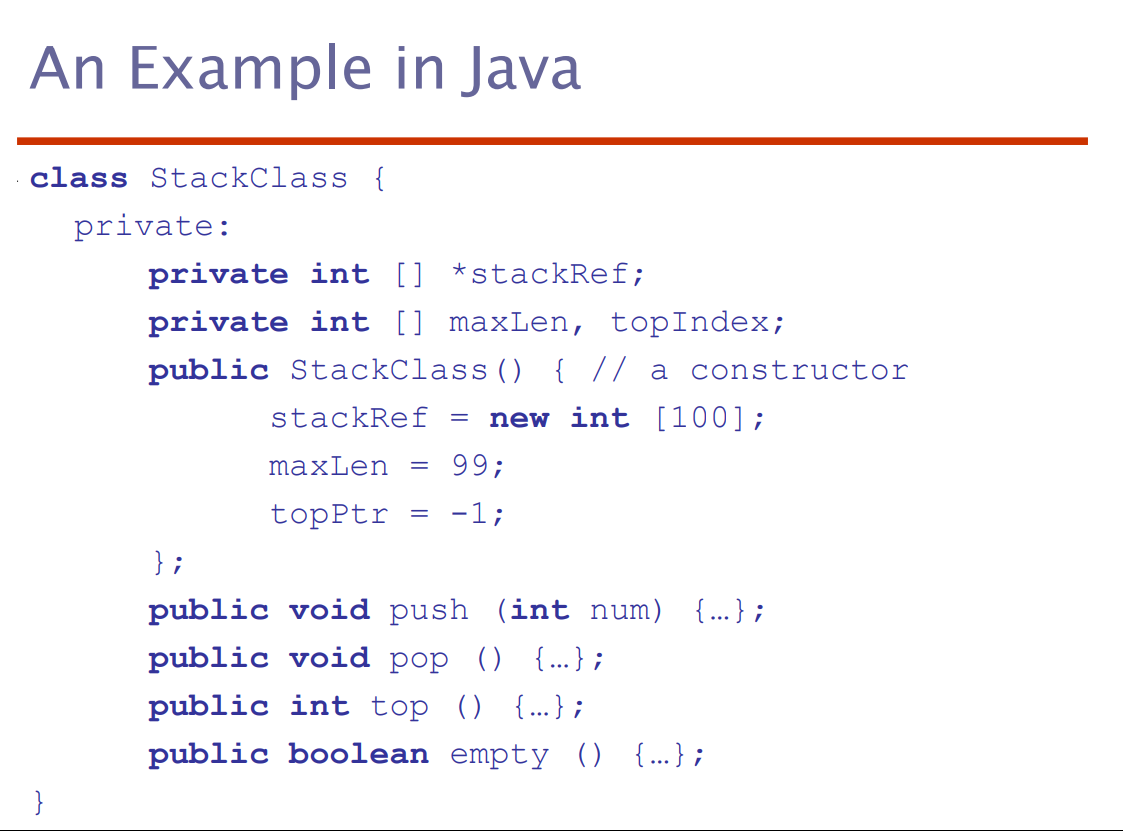
access control modifiers (private or public) - clauses
Language Examples: Java
Similar to C++, except:
Individual entities in classes have—, rather than —
second scoping mechanism, package scope,
visible
Language Examples: Java
Similar to C++, except:
Java has a — which can be used in place of friends
All entities in all classes in a package that do not have access control modifiers are — throughout the package
C#
internal and protected internal
heap dynamic
Language Examples: —
Based on C++ and Java
Adds two access modifiers, —
All class instances are —
C#
Default constructors
Garbage collection
structs
Language Examples: C#
— are available for all classes
— is used for most heap objects, so destructors are rarely used
— are lightweight classes that do not support inheritance

accessor methods (getter and setter)
properties
Language Examples: C#
Common solution to need for access to data members: —
C# provides —as a way of implementing getters and setters without requiring explicit method calls
Parameterized Abstract Data Types
—
allow designing an ADT that can store any type elements
only an issue for static typed languages
generic classes
C++, Java 5.0, and C# 2005
Parameterized Abstract Data Types
Also known as —
(3) provide support for parameterized ADTs

parameterized constructor functions
Stack stk(150);
Parameterized ADTs in C++
Classes can be somewhat generic by writing —
A declaration of a stack object:
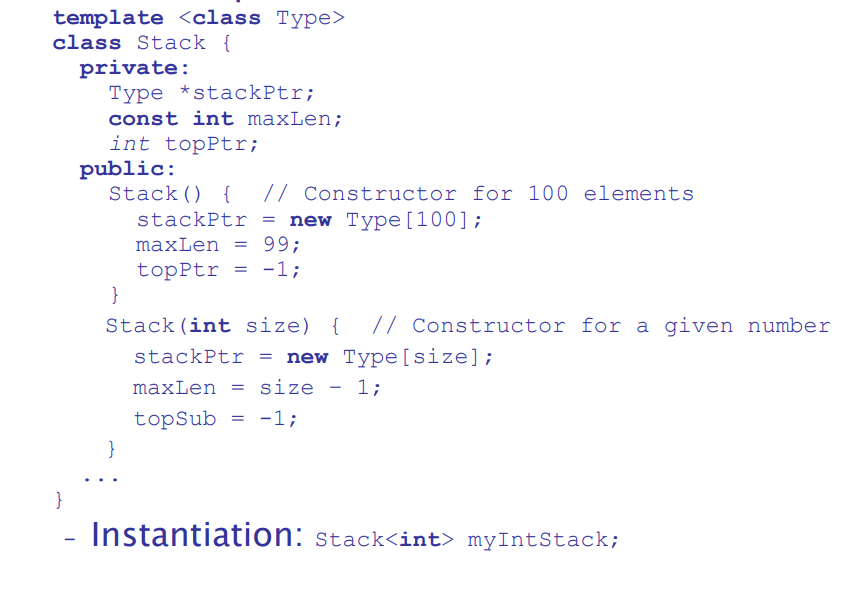
templated class
Stack myIntStack;
Parameterized ADTs in C++
The stack element type can be parameterized by making the class a —
Instantiation: —
Java 5.0
classes
collection types
LinkedList and ArrayList
Parameterized Classes in —
Generic parameters must be —
Most common generic types are the —, such as —
Eliminate the need to cast objects that are removed
Eliminate the problem of having multiple types in a structure
Users can define generic classes
Generic collection classes cannot store primitives
Indexing is not supported
cast objects
multiple types in a structure
Parameterized Classes in Java 5.0
Eliminate the need to — that are removed
Eliminate the problem of having —
Users
primitives
Indexing
Parameterized Classes in Java 5.0
— can define generic classes
Generic collection classes cannot store —
— is not supported

myArray.add(0, 47); // Put an element with subscript 0 in it
Parameterized Classes in Java 5.0
Example of the use of a predefined generic class:
ArrayList myArray = new ArrayList ();
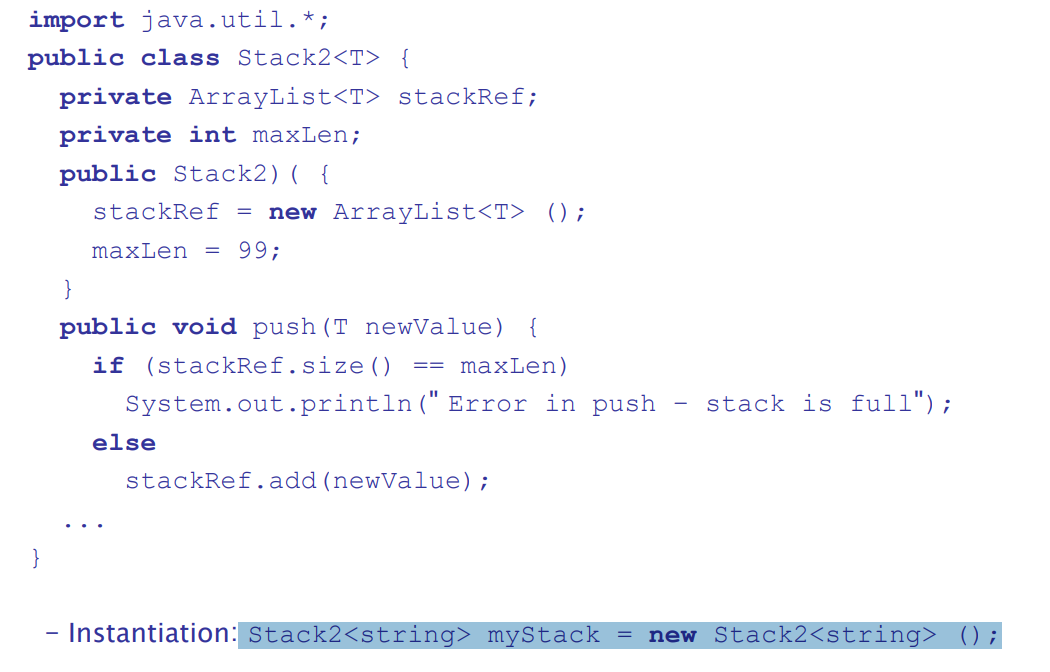
Stack2 myStack = new Stack2 ();
Parameterized Classes in Java 5.0
Instantiation:
C# 2005
Parameterized Classes in —
Similar to those of Java 5.0, except no • Predefined for Array, List, Stack, Queue, and Dictionary • Elements of parameterized structures can be accessed through indexing
C# 2005
wildcard classes
Parameterized Classes in —
Similar to those of Java 5.0, except no —
Predefined for Array, List, Stack, Queue, and Dictionary
Elements of parameterized structures can be accessed through indexing
Array, List, Stack, Queue, and Dictionary
indexing
Parameterized Classes in C#2005
Predefined for (5)
Elements of parameterized structures can be accessed through —
Encapsulation Constructs
means of organization
means of partial compilation
—
Large programs have two special needs:
Some —, other than simply division into subprograms
Some — (compilation units that are smaller than the whole program)
separately compiled
encapsulation
Encapsulation Constructs
Obvious solution: a grouping of subprograms that are logically related into a unit that can be — (compilation units)
Such collections are called —
Nested Subprograms
Python, JavaScript, and Ruby
Organizing programs by — definitions inside the logically larger subprograms that use them
are supported in (3)
C
independently compiled
header file
Encapsulation in —
Files containing one or more subprograms can be —
The interface is placed in a —
linker
pointers
Encapsulation in C
Problem 1: the — does not check types between a header and associated implementation
Problem 2: the inherent problems with —
#include preprocessor specification – used to include header files in applications
#include preprocessor specification
Encapsulation in C
— used to include header files in applications
C++
header and code files
encapsulation
interface (prototypes)
Encapsulation in —
Can define —, similar to those of C
Or, classes can be used for —
The class is used as the —
member definitions
Friends
Encapsulation in C++
The — are defined in a separate file
— provide a way to grant access to private members of a class
C# Assemblies
single dynamic link library or executable
separately compiled
—
A collection of files that appears to application programs to be a —
Each file contains a module that can be —
DLL
internal
internal member
C# Assemblies
A — is a collection of classes and methods that are individually linked to an executing program
C# has an access modifier called —;
an — of a class is visible to all classes in the assembly in which it appears
global names
logical groupings
Naming Encapsulations
Large programs define many —; need a way to divide into —
naming encapsulation
C++ Namespaces
C#
A — is used to create a new scope for names
– Can place each library in its own namespace and qualify names used outside with the namespace
— also includes namespaces
Java Packages
partial friends
fully qualified name
Naming Encapsulations
— Packages can contain more than one class definition; classes in a package are —
Clients of a package can use — or use the import declaration
Ruby classes
modules
constants and methods
Naming Encapsulations
— are name encapsulations, but Ruby also has —
Typically encapsulate collections of —
Modules cannot be instantiated or subclassed, and they cannot define variables
Methods defined in a module must include the module’s name
Access to the contents of a module is requested with the require method